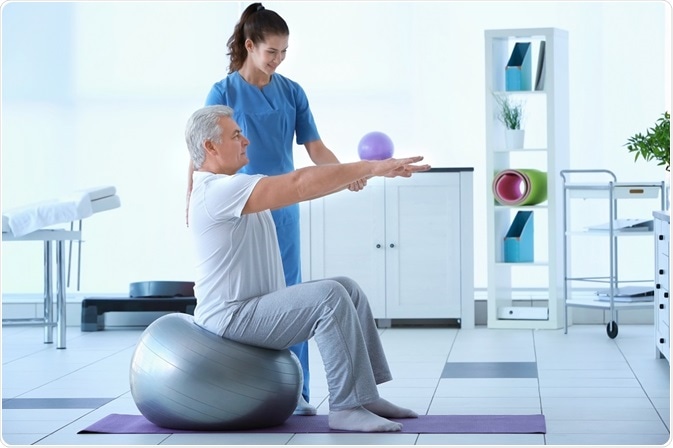
Pulmonary Rehabilitation for COPD
Pulmonary rehabilitation is an 8-12 week program encompassing several aspects of pulmonary care for the improvement of lung function in patients with respiratory disorders such as Chronic Obstructive Pulmonary Disorder (COPD).
 Image Credit: Africa Studio / Shutterstock
Image Credit: Africa Studio / ShutterstockCOPD is a condition characterized by marked obstruction of the airway passage, shortness of breath, and wheezing due to underlying pathophysiologic changes in the body. It is one of the leading causes of death, competing with cardiovascular, oncological, and infectious ailments.
Dedicated centers for pulmonary rehabilitation are run by medical centers, and sometimes charitable organizations, which focus on respiratory wellness as a community goal. The treating physician may refer patients to such programs upon consideration that a holistic approach is required in addition to medicinal treatment.
For example, COPD patients with frequent exacerbations and those with physical or emotional frailty are otherwise at high risk of recurring acute problems associated with COPD and a resultant poor quality of life. These patients benefit greatly from pulmonary rehabilitation.
A typical pulmonary rehabilitation program involves:
- Physical training and exercise tolerance
- Food and nutrition
- Support for de-addiction from smoking
- Correct usage of inhalers and nebulizers for optimal outcomes
- Community sharing
- Self-care plan
- Regular follow-ups
Exercise
Patients with COPD often have limited physical activity as they become severely breathless during moderately intense physical activity. Although it may seem quite reasonable for COPD patients not to get involved in strenuous exercises, it is also unhealthy to remain completely inactive.
Like other muscles in the body, respiratory tract muscles can also atrophy if unused for a long period of time.
In the pulmonary rehabilitation center, trained professionals including physiotherapists, nurses, and lung function specialists address small batches of patients. Generally, patients are enrolled onto a regime that includes exercise three times per week. Most programs last 8-12 weeks, but some patients may need support for a longer period of time. Prescribed activities include:
- Intensity training: Patients are given a chance to learn and increase the intensity of their exercises at their own comfortable pace. In several studies, results of high intensity training have been significantly higher compared to low intensity training.
- Interval training: Physicians employ two different approaches–one involving continuous training of moderate or low intensity, and the other involving short intervals of intense nature. In clinical studies, both methods empirically showed similar benefits. Therefore, the choice of method really depends on the physician’s judgment and the age and capacity of the patient.
- Duration of training: Many researchers have compared the lung function outcomes of patients with COPD. It has commonly been found that those who take part in physical training over a long period of time,in addition to the usual care, have a better quality of life than those with the condition who do not exercise. Even short exercise regimes have been shown to significantly improve quality of life for most patients.
Personalized approaches to pulmonary rehabilitation for COPD
Pulmonary rehabilitation, as an approach, has a potential of improving the quality of life of patients. When correctly coupled with the other treatment modalities, the results can be extraordinary. However, it has become widely accepted that no single management approach can suit the entire population. When considering the heterogeneous nature of COPD, no two patients can be treated with a single treatment yielding identical outcomes.
Over the last 30 years, research has led physicians to acknowledge various clinical, physiologic, and radiologic phenotypes of COPD. As a result, personalized training programs and tailor-made rehabilitation are now emerging as a mainstay treatment for COPD.
Advantages of pulmonary rehabilitation
Although pulmonary rehabilitation is mainly seen to focus on exercise, programs involve much more than physical training.
Improvements in confidence as a result of physical activity can uplift the spirits of a patient with COPD significantly. Smoking cessation and healthy eating are just some of the habits that a patient could gain from a rehabilitation program. These habits are universally beneficial irrespective of disease status.
Patients who undergo pulmonary rehabilitation are more knowledgeable about their condition, as the program increases their awareness of primary remedies and precautions that they have be wary of.
Dangers of pulmonary rehabilitation
Along with numerous benefits of pulmonary rehabilitation, there are still some identified risks as well. These include the risk of injuries while performing exercises incorrectly or overdoing the exercises. The susceptibility of patients to cardiac problems also increases if there is comorbid cardiovascular condition.
These risks could nevertheless be easily minimized by seeking professional help and making the therapist aware and informed about any existing or perceived medical problems.
Sources:
- What is Pulmonary Rehabilitation? COPD Foundation.
- Personalised pulmonary rehabilitation in COPD. European Respiratory Review.
- Pulmonary rehabilitation for COPD. Respiratory Medicine.
- Pulmonary Rehabilitation for COPD . Journal of Respiratory Diseases, Thoracic Surgery, Intensive Care and Tuberculosis.
- Keeping active with a lung condition. British Lung Foundation.
- The Basics of Pulmonary Rehabilitation. American Lung Association.
- Pulmonary Rehabilitation. COPD.
Further Reading
Last Updated: Aug 23, 2018






















.png)









No hay comentarios:
Publicar un comentario